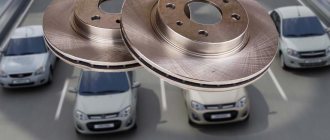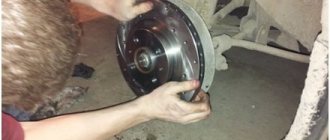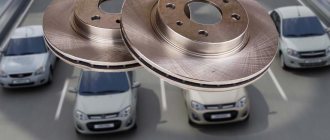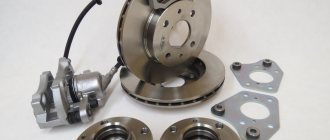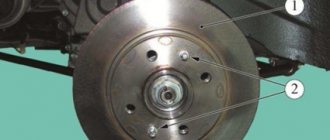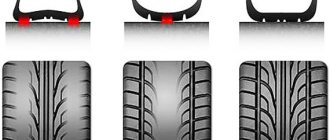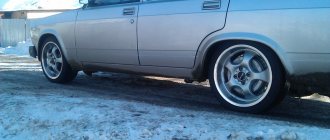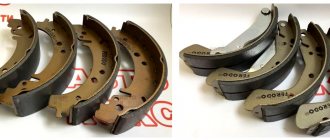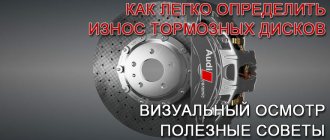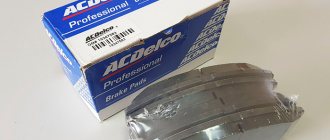The minimum permissible thickness of a non-ventilated disk is A = 10.8 mm, ventilated - 17.8 mm. If the disk thickness is less, it must be replaced. The axial runout of the brake disc surface should not exceed 0.15 mm.
If there are burrs, deep scratches, etc. on the working surface of the disc that increase pad wear and reduce braking efficiency, replace the disc. In specialized workshops such a disc can be sharpened and ground. But at the same time, the thickness of the disk must be no less than the minimum permissible. The groove is made on both sides of the disk to the same depth.
The brake disc of a car, working in intensively stressful conditions and in unfavorable external conditions, ensures the safety of our movement. This axiom. But, while performing complex and responsible work, the disc itself, seemingly made of strong material, remains very vulnerable to damage by a part of the brake system.
Brake disc diagnostics
Disc brakes, having burst into our lives in the middle of the last century, confidently won a leading position in car design. Today, almost 90% of passenger cars leave production lines with disc brakes already installed. The reason is simple - disc brakes are more efficient and simpler in design. Which means it’s cheaper for mass production.
A not entirely good feature of disc brakes is the small contact area between the pad and the brake disc. This, in turn, requires more pressure in the brake system, and increased wear on both the brake pads and the brake disc.
What should be the minimum thickness of a brake disc to allow operation of a car? We will not give you a single figure, which varies significantly between manufacturers of both cars and brake discs. And although there are average mileage figures, it's all relative.
On forums, many novice motorists ask the question where they can find out numbers about the thickness of the brake disc. Let’s answer this: right on the disk it’s possible. The fact is that the manufacturer took care of our comfort when repairing brake discs and indicated two numbers on the end of the brake disc: the original thickness and the minimum thickness of the brake disc. After this figure, operating the car is strictly not recommended.
Numbers are numbers, but too many factors influence accelerated wear of brake discs. Among the first is your aggressive driving style within the city.
Tuning brakes without modifications for Lada Granta, Priora and Kalina
17 June 2016 LadaOnline 62,528
Depending on the configuration, the manufacturer equips Lada cars with different front brakes. We determine which brake discs AvtoVAZ installs on Priora, Granta and Kalina, what is the difference between the front brake mechanisms, and how to very easily improve the brakes without modifications.
What kind of front brakes does AvtoVAZ install on the Lada?
| Where are they installed? | Lada Kalina and Granta from 8th grade. engine | Lada Priora (8 and 16 grades), Kalina, Granta (16 grades) | Lada Kalina and Granta sport |
| Visual differences | The brake disc is significantly smaller than the boot | The brake discs are completely covered by the boot | Installed only on sports versions of Lada cars |
| Front brake part numbers |
|
|
|
| Suitable wheel rims | R13 and more | R14 and more | R15 and more |
Installing R14 brakes instead of R13
According to the data from the table, you can see that to switch from R13 to R14 brake discs, no modifications are required and the cost of modification is low (buy R14 brake discs and fixed caliper brackets).
Don't forget to check that the rims are at least R14 in diameter. We improve the brakes using the familiar instructions for replacing brake discs.
Most car owners, after installing R14 brake discs, feel a noticeable difference when braking and remain satisfied. However, this is not the limit, the brakes can be made even better!
How to determine brake disc wear: acceptable standards and features
The brake disc is no less important in the braking system of a car than the pads. And if the latter are replaced when worn out, then almost no attention is paid to the former. But the efficiency of the system also depends on them. Let's find out how to determine the wear of brake discs so that they can be replaced on time.
Most of the discs that lie on the shelves of car dealerships are made of cast iron. The popularity of such products lies in their low cost and good friction characteristics. But the problem is that in the process of reducing the speed, the cast iron alloy product heats up. This leads to deformation, warping, and uneven abrasion. To reduce wear and tear from heat, manufacturers began to produce products with ventilation. Grooves are also cut on the surface of the disk. This allows you to increase the life of the disk.
Stories from our readers
“Fucking basin. "
Hi all! My name is Mikhail, now I’ll tell you a story about how I managed to exchange my two-wheeler for a 2010 Camry. It all started with the fact that I began to be wildly irritated by the breakdowns of the two-wheeler, it seemed like nothing serious was broken, but damn it, there were so many little things that really started to irritate me. This is where the idea arose that it was time to change the car to a foreign car. The choice fell on the melting Camry of the tenth years.
Yes, I had matured morally, but financially I just couldn’t handle it. I’ll say right away that I am against loans and taking a car, especially not a new one, on credit is unreasonable. My salary is 24k a month, so collecting 600-700 thousand is almost impossible for me. I started looking for different ways to make money on the Internet. You can’t imagine how many scams there are, what I haven’t tried: sports betting, network marketing, and even the volcano casino, where I successfully lost about 10 thousand ((The only direction in which it seemed to me that I could make money was currency trading on the stock exchange, they call it Forex. But when I started delving into it, I realized that it was very difficult for me. I continued to dig further and came across binary options. The essence is the same as in Forex, but it’s much easier to understand. I started reading forums, studying trading strategies. I tried it on a demo account, then opened a real account. To be honest, I didn’t manage to start earning money right away, until I understood all the mechanics of options, I lost about 3,000 rubles, but as it turned out, it was a precious experience. Now I earn 5-7 thousand rubles a day. I managed to get the car buy after half a year, but in my opinion this is a good result, and it’s not about the car, my life has changed, I naturally quit my job, I have more free time for myself and my family. You’ll laugh, but I work directly on the phone)) If If you want to change your life like me, then here’s what I advise you to do right now: 1. Register on the site 2. Practice on a Demo account (it’s free). 3. As soon as you get something on the Demo account, top up your REAL ACCOUNT and go to REAL MONEY! I also advise you to download the application to your phone, it’s much more convenient to work from your phone. Download here.
Minimum permissible thickness of brake discs:
- For ventilated 17.8 mm
- For non-ventilated 10.8 mm
Brake discs are distinguished:
- Ventilated discs
- With gas outlets
- With perforation or grooves (slots)
- Collapsible
Let's look at each point in more detail.
The first option is ventilated discs . They are two separate disks, fastened together in such a way that they resemble blades (like a turbine). Thanks to these blades and channels, heat is dissipated more efficiently and the weight of the disc is reduced. Example of simple ventilated brake discs .
During active braking, if the brake discs are not cooled enough, their temperature can reach 180-250 degrees. Regular pads start to smoke. The gas released when the pads rub against the heated disc serves as a layer between the disc and the pad and prevents the pads from fitting tightly to the brake disc. This is the main problem why braking disappears . To prevent such cases, there are gas outlets, perforations and grooves. An example of brake discs with gas outlets .
Another reason for brake failure can be carbon deposits on the pads, which appears during frequent braking (on a race track). This carbon deposit turns the block into a slippery ski. Gas outlets and perforations cut off this slippery layer, renewing the pad. But they make brake pads wear out faster . Example of brake discs with perforations and grooves .
In addition, perforations together with grooves help remove water, dirt, and dust, which reduces the risk of scratching the brake disc. They also increase additional braking force and reduce disc wear . An example of brake discs with gas outlets and perforations .
The fourth option is collapsible disks . As we already know, when braking, the brake discs heat up and the heat is transferred to the hub, and at high temperatures this unit is likely to fail. This is why some companies offer collapsible brake discs . They are a working disk, which is bolted to the middle part, which is attached to the hub. An example of dismountable brake discs .
Because The majority of car owners operate their cars on city roads, and not on ring tracks and races, then the effectiveness of standard brakes will be sufficient . If you still want to improve the car's braking system , then you should not install rear disc brakes, but rather change the brake discs to a larger diameter and install perforated brake discs . You will feel the difference immediately, not only in braking, but also in the appearance of your car (for example, by illuminating perforated wheels with LEDs).
